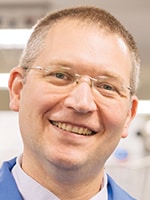In a roundtable, platform change pointers
Valerie Neff Newitt
June 2023—Transporting specimens to the laboratory, and processing and distributing them within the lab, will be what AACC meeting-goers hear about in a session next month.
In another session, making inefficient workflows more efficient with technology that’s available now will be one speaker’s focus. And in one of the many roundtables, a leader will talk about how to ensure a successful go-live for a new clinical chemistry analyzer.
Just some of what awaits in the way of advances in lab transport and efficiencies for core and other laboratories.
“I don’t think we hold the same standards of monitoring temperatures for our specimens that we do for our reagents,” says Joe Wiencek, PhD, D(ABCC), a scheduled speaker and service line medical director of the Vanderbilt University Medical Center core laboratory and medical director of clinical chemistry. He describes himself as “almost the town crier” on the importance of proper external specimen transport to the lab. “We really do need to address it,” he says.

Dr. Wiencek
He and others are doing that now in the form of the first Clinical and Laboratory Standards Institute document on the evaluation of external specimen transport processes. It’s in the final development phase, says Dr. Wiencek, the group’s chair. “We’ve been meeting for about a year and a half with a globally diverse group of individuals who are dedicated to getting a document together on all the useful information that’s been published for the benefit of all clinical labs as well as clinical areas of medicine.”
He organized the AACC session on advances in transport to highlight prospective ways to standardize the approach to specimen handling and transport, “regardless of your climate zone,” he says. “Patient specimens must be kept in appropriate temperatures throughout the transport process.”
The summertime heat in Nashville sparked his interest in external transport. “I started to notice that some of the courier boxes bake in the sun, so we started to study this. And it’s become even more important recently because of the heat waves that are impacting all regions in the United States and other areas of the world.”
When Dr. Wiencek thinks of external specimen transport, he thinks, too, of 2019 and the polar vortex. “That resulted in extreme cold in the North and Midwest. And that same year there was a heat wave in Phoenix, Arizona, where the paint was melting off the street signs and several cargo and transport planes were grounded. We should be thinking about the effects of extreme heat and cold on our patient specimens.”
The CLSI document that is in the works, and his session next month, are about “making sure we have the proper guidance and support for the transport of those specimens from point A to point B,” he says.
Dr. Wiencek was a coauthor of a paper published in the American Journal of Clinical Pathology on the guidance provided by a group of academic, private, and reference labs to their clients on how to store and ship specimens (Dibbern ME, et al. Am J Clin Pathol. 2021;156[5]:866–870). “The only thing that was consistent among all those groups were the inconsistencies associated with their transport processes,” he says, such as how many cold packs to use and where to place the storage box. His discussions with people in the clinics who use the boxes reveal that a box’s placement “is up to them,” he says. “They could put the courier box wherever they feel like putting it,” including on the side of the building where there’s sunlight for extended hours.
Dr. Wiencek selected his co-speakers for the transport session, one of whom is Timothy Amukele, MD, PhD, of Icon Clinical Research, who will talk about the use of drones. “Dr. Amukele was one of the first individuals in the world to start to look at drones as a way to transport specimens, and that has kind of grown. It’s important to think about not only for rural settings but also urban settings,” where traffic is heavy and where the specimens have to be transported to an offsite clinical laboratory or core lab, he says.

Dr. Genzen
Jonathan Genzen, MD, PhD, chief medical officer at ARUP Laboratories and the third speaker, will take attendees inside the lab with a look at efficiency in specimen processing and distribution through automation.
“There are certainly opportunities for efficiency and improvement in many areas around the lab,” including specimen handling and integrity checks for hemolysis, icterus, and lipemia, where automation can help, says Dr. Genzen, who chairs the CAP Clinical Chemistry Committee. At ARUP, he and others are investigating the use of autonomous intelligent vehicles. “Basically mobile robots that can help distribute specimens across laboratory areas,” he says. “In our case it’s across buildings and even a bridge.” He’ll share examples and photos of what they’re testing at ARUP.
The technology itself isn’t new, he notes, but the improved quality of the robotics and the ability to use wireless networks to tell the robotics where they need to go is noteworthy. “The robots can detect whether there is anything blocking their path—a person, a cart, or something else. The sensors on these robotics are much better than they were in the past.” He says he and his colleagues have found the technology to be particularly useful in specimen distribution. “We use autonomous intelligent vehicles, for example, to bring specimens to our automated storage unit after testing is complete.”
He’ll talk, too, about robotic process automation, which is not about robots but about automating manual repetitive tasks within a computer system. RPA is a technology that is widely used in other industries and makes it possible to define what the steps are and then do them automatically in the future. “We think RPA has a lot of potential in specimen processing and information handling within the laboratory system, and we have several RPA initiatives ongoing,” he says of ARUP.
Two other areas need attention, in Dr. Genzen’s view, one of which is lab automation for pediatric specimens. “We need a commitment and maybe a certain research and development effort to find ways to allow pediatric specimens to benefit from the same level of automation” as adult specimens, he says.
The other was brought to light during the pandemic. Chemistry automation is built around relatively standardized tube sizes and shapes, he notes, at least for adult specimens. In infectious disease, different systems may be built for unique sizes and shapes of tubes, swabs, and collection media. “We found during the COVID pandemic that automation, when you’re receiving a variety of types of tubes, can be incredibly challenging. We’re at a phase where, in this post-public health emergency world, we should start actively thinking about what that system should look like in the future with standardization of tube and swab sizes and shapes, so that the laboratory community doesn’t encounter the same struggles with automation that we saw in the pandemic.”
The pandemic also brought new levels of strain on staff, which is why the need to optimize workflow is pressing, says Simone Arvisais-Anhalt, MD, director of laboratory informatics, send-out testing, and specimen processing at the University of California San Francisco. She’ll speak with others in a session on reimagining lab operations and harnessing technology to do more work. “People are feeling undervalued from a variety of factors, but certainly the pandemic exacerbated that,” she says.

Dr. Arvisais-Anhalt
It’s not only medical technologists and clinical laboratory scientists who feel the strain, Dr. Arvisais-Anhalt adds. “Today we are a very technology-intensive field. We are so IT heavy that our laboratory information system teams and IT support feel the strain as well.”
As treatment paradigms change, laboratory teams are working equally rapidly to meet those needs, she notes. “So we’re in a difficult situation where we’re always trying to play catch-up. We’re bringing on new assays, new platforms. But when it comes to implementing them, from an IT perspective, we end up getting maybe 80 percent of the way there. When it comes to the last mile, sometimes we just run out of steam, whether it be funding or the time and attention we can devote.”
“And when you dig down deep into the workflows,” she says, it’s clear “they haven’t been optimized,” not, at least, on par with optimizing physical space, as in Lean. With so much of the laboratory’s work in the “digital space,” Dr. Arvisais-Anhalt says, “it’s an opportunity for improvement.” In her AACC presentation, she will share ideas for inefficient workflows and give attendees the opportunity to identify their own inefficient workflows, and “we’ll look at the technology that exists and that most labs would have and that can be deployed to optimize them.” She’ll talk also about technologies that are evolving—robotic process automation, for one—and soon to come to optimize inefficient workflows.
While new and flashy is appealing, she says, she’s most excited about using more fully the software that is already available. “In the current financial environment, not every institution is positioned to onboard new expensive technology, even if it can create great value. So let’s just turn our attention to what we already have and how, with extra attention and deliberate intent, we can use the existing technology to make things better.” She compares it to a Lean optimization of the lab, where the physical space is rearranged to achieve that optimization.
The workflow for allergen send-out testing at UCSF underwent improvement recently, from a manual-intensive process to one with an interface “where there are no middle people,” she says. “We’re realizing just how high yield of a gain it was to have this interface and what an incredibly inefficient and cumbersome workflow we had previously. Are there others like that where we can make disproportionate gains in terms of time saved and patient safety? That’s the big question.”
The task of replacing laboratory analyzers can be long and daunting, especially when there’s a change of vendors. Melissa Budelier, PhD, D(ABCC), will offer in her roundtable discussion tips for a successful go-live with new laboratory analyzers. “There’s a lot more to it than just the analytical validation,” she notes. “That’s the easy part.” Dr. Budelier is medical director of clinical chemistry and toxicology at TriCore Reference Laboratories and a member of the CAP Standards Committee. Her roundtable will focus on changing clinical chemistry platforms, she says, “but the lessons learned are applicable to any laboratory vendor change process.”
Reference intervals, comments in reports, cardiac troponin testing, and tumor markers are just a few examples of what could change with a chemistry analyzer change. “Once you’ve decided what analyzer to bring in, that’s really when you get started,” she says, adding that the laboratory must engage the right teams early on. “Especially IT,” she says. “Almost all changes require input from your IT team.” Additional teams to engage include but aren’t limited to lab staff, operations, facilities, project management (if available), and other stakeholders, including ordering providers.

Dr. Budelier
Strong communication and planning are two keys to a successful go-live, she says. Dr. Budelier’s hope is that attendees will leave the discussion with insights that are helpful in developing a plan and timeline for implementing new analyzers in their labs. “It’s an interactive session,” she says. “The goal is for us to learn from each other.”
Valerie Neff Newitt is a writer in Audubon, Pa.